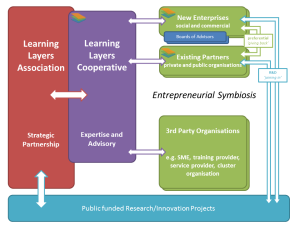Start of Learning Toolbox pilots in Bau-ABC – Part One: The Kick-off event 14.3.2016
On Monday the 14th of March we experienced a great day for our EU-funded Learning Layers (LL) project. We had the kick-off event of the piloting with the Learning Toolbox (LTB) in Bau-ABC (the training centre for construction sector in Rostrup). On the whole, this was a manifold event with different sessions and different activities (with focus on tool development, implementation in different trades and evaluation measures). And, moreover, the event was organised as parallel activities in two trades – the carpenters (Zimmerer) and the well-builders (Brunnenbauer). In this post I try to give some first-hand impressions on the sessions with the group of carpenters (and complement them with some remarks on the parallel group of well-builders). I know that the evaluators from the LL team of the University of Innsbruck (UIBK) will give more detailed accounts on these sessions and on their recordings on the talks with apprentices. From my perspective it is important to get a picture on the process that was kicked off with the Learning Toolbox (LTB) to be used by the apprentices.
Introduction of the Learning Toolbox (LTB) in the group of carpenters (Zimmerer)
In the group of carpenters we (the LL project partners) had firstly the chance to present the Learning Toolbox as an integrative toolset to be used in the forthcoming training projects of the apprentices. Gilbert Peffer presented the essentials and then the apprentices installed the LTB apps on their smartphones. Then the trainer of carpenters, Fidi Bruns explained the training project of the next few weeks for the group. After this session and a break, the other trainer of carpenters, Markus Pape, gave an overview of the parent stack and of the daughter stacks that he had prepared for the project. After these introductory sessions we had a group discussion with the carpenter apprentices (recorded by the UIBK colleagues). In this discussion the apprentices felt very positive about the new toolset and on the prospect to use digital media and web resources in their projects. In a similar way they were keen to get the LTB to work on their devices. They were also pleased to participate in instant debugging talks in the cases in which the installation caused problems.
Introduction of the Learning Toolbox (LTB) in the group of well-builders (Brunnenbauer)
In the parallel group of well-builders the introduction of LTB had already taken place one week before and the project using LTB had already been started. Yet, there was some need for assistance in the installation as well as real-time debugging. Also, the approach in developing project-related stacks was somewhat different – instead of shaping a parent stack and daughter stacks the well-builders were equipped with a set of thematic stacks that will be networked with each other.
The way forward
During the event we had teams of ITB (accompanying researchers), LTB developers (RayCom, CIMNE) and evaluators (UIBK). In addition we had as a special support agent Jaanika Hirv (TLU) who stayed one week in Bau-ABC to collect feedback from apprentices and trainers on their first steps working with the LTB. She reported this feedback with daily e-mails that were collected into a Google Doc. Then, in the second round, Gilbert Peffer and Jaanika had exchanges on these messages (in the same Google Doc). Summaries of the conclusions were then reported back on a German-speaking ‘hotline’ mailing list “LTB Pilot”. In my next posts I will report on a follow-up visit to Bau-ABC and then have a look at the working issues that have come up in our talks and e-mail correspondence.
More posts to come …

